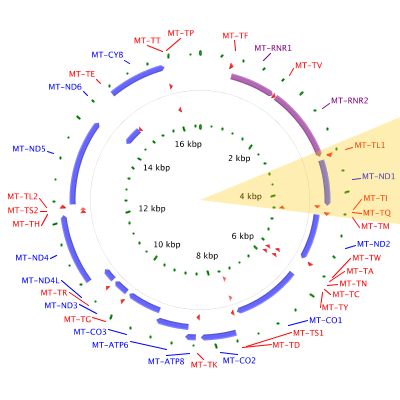Reviewed November 2006
What is the official name of the MT-ND1 gene?
The official name of this gene is “mitochondrially encoded NADH dehydrogenase 1.”
MT-ND1 is the gene's official symbol. The MT-ND1 gene is also known by other names, listed below.
What is the normal function of the MT-ND1 gene?
The MT-ND1 gene provides instructions for making a protein called NADH dehydrogenase 1. This protein is part of a large enzyme complex known as complex I, which is active in mitochondria. Mitochondria are structures within cells that convert the energy from food into a form that cells can use. These cellular structures produce energy through a process called oxidative phosphorylation, which uses oxygen and simple sugars to create adenosine triphosphate (ATP), the cell's main energy source.
Complex I is one of several enzyme complexes necessary for oxidative phosphorylation. Within mitochondria, these complexes are embedded in a tightly folded, specialized membrane called the inner mitochondrial membrane. During oxidative phosphorylation, mitochondrial enzyme complexes carry out chemical reactions that drive the production of ATP. Specifically, they create an unequal electrical charge on either side of the inner mitochondrial membrane through a step-by-step transfer of negatively charged particles called electrons. This difference in electrical charge provides the energy for ATP production.
Complex I is responsible for the first step in the electron transport process, the transfer of electrons from a molecule called NADH to another molecule called ubiquinone. Electrons are then passed from ubiquinone through several other enzyme complexes to provide energy for the generation of ATP.
How are changes in the MT-ND1 gene related to health conditions?
-
Leber hereditary optic neuropathy - caused by mutations in the MT-ND1 gene
-
Several mutations in the MT-ND1 gene are known to cause Leber hereditary optic neuropathy. Each of these mutations changes a single DNA building block (nucleotide) in the gene. One common MT-ND1 mutation is responsible for about 13 percent of all cases of Leber hereditary optic neuropathy. This mutation replaces the nucleotide guanine with the nucleotide adenine at gene position 3460 (written as G3460A). This change is associated with moderately severe cases of Leber hereditary optic neuropathy; however, 20 percent to 40 percent of people with vision loss due to this mutation experience some recovery of vision.
Researchers are investigating how mutations in the MT-ND1 gene lead to Leber hereditary optic neuropathy. These genetic changes appear to disrupt the normal activity of complex I in the mitochondrial inner membrane, which may affect the generation of ATP. MT-ND1 mutations also may increase the production within mitochondria of potentially harmful molecules called reactive oxygen species. It remains unclear, however, why the effects of these mutations are often limited to the nerve that relays visual information from the eye to the brain (the optic nerve). Additional genetic and environmental factors probably contribute to the vision loss and other medical problems associated with Leber hereditary optic neuropathy.
-
mitochondrial encephalomyopathy, lactic acidosis, and stroke-like episodes - caused by mutations in the MT-ND1 gene
-
MT-ND1 mutations are a rare cause of mitochondrial encephalomyopathy, lactic acidosis, and stroke-like episodes (MELAS). Most cases of MELAS are caused by mutations in other mitochondrial genes, but a small number of cases resulting from mutations in the MT-ND1 gene have been reported. Fewer than five mutations, each of which alters a single DNA building block (nucleotide) in the gene, have been identified in affected individuals. These genetic changes reduce the activity of complex I, which disrupts energy production within mitochondria. Although these abnormalities have the greatest impact on tissues that require a lot of energy (such as the brain and muscles), researchers have not determined how changes in the MT-ND1 gene lead to the specific signs and symptoms of MELAS.
- other disorders - associated with the MT-ND1 gene
-
A mutation in the MT-ND1 gene has been reported in a few cases of adult-onset dystonia. Dystonia is a movement disorder that involves involuntary tensing of the muscles (muscle contractions), tremors, and other uncontrolled movements. The MT-ND1 mutation associated with these rare cases replaces the nucleotide adenine with the nucleotide guanine at gene position 3796 (written as A3796G). Further studies are needed to determine whether this genetic change combines with other genetic and environmental factors to increase the risk of developing adult-onset dystonia.
Where is the MT-ND1 gene located?
The MT-ND1 gene is located in mitochondrial DNA.
Molecular Location in mitochondrial DNA: base pairs 3,307 to 4,263


Where can I find additional information about MT-ND1?
You and your healthcare professional may find the following resources about MT-ND1 helpful.
-
-
-
Gene Tests - DNA tests ordered by healthcare professionals (3 links)
You may also be interested in these resources, which are designed for genetics professionals and researchers.
- PubMed
 - Recent literature
- Recent literature
- OMIM
 - Genetic disorder catalog
- Genetic disorder catalog
-
What other names do people use for the MT-ND1 gene or gene products?
- MTND1
- NADH dehydrogenase 1
- NADH dehydrogenase subunit 1
- NADH-ubiquinone oxidoreductase chain 1
- NADH-ubiquinone oxidoreductase, subunit ND1
- ND1
- NU1M_HUMAN
Where can I find general information about genes?
The Handbook provides basic information about genetics in clear language.
These links provide additional genetics resources that may be useful.
What glossary definitions help with understanding MT-ND1?
The resources on this site should not be used as a substitute for
professional medical care or advice. Users seeking information about
a personal genetic disease, syndrome, or condition should consult with a qualified
healthcare professional.
See How can I find a genetics professional in my area? in the Handbook.
